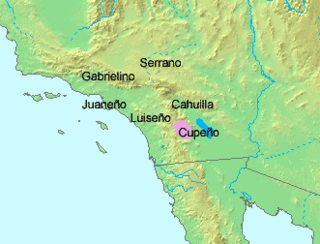

| Cupeño | |
|---|---|
| Kupangaxwicham Pe'me̲melki | |
| Region | Southern California, United States |
| Ethnicity | Cupeño |
| Extinct | 1987, with the death of Roscinda Nolasquez |
| Revival | [1] |
| Latin | |
| Language codes | |
| ISO 639-3 | cup |
| Glottolog | cupe1243 |
| ELP | Cupeño |
 | |

Cupeño is classified as Extinct by the UNESCO Atlas of the World's Languages in Danger | |
| This article contains IPA phonetic symbols. Without proper rendering support, you may see question marks, boxes, or other symbols instead of Unicode characters. For an introductory guide on IPA symbols, see Help:IPA. | |
The Cupeño language, an extinct Uto-Aztecan language, was once spoken by the Cupeño people of Southern California, United States.
Roscinda Nolasquez (d. 1987) was the last native speaker of Cupeño.[3] The Cupeño people now speak English. The native name Kupangaxwicham means 'people from the sleeping place', referring to their traditional homeland, prior to 1902, of Ktipa (at the base of Warner's Hot Springs).[4][5] A smaller village was located to the south of Ktipa, named Wildkalpa.
Throughout the 1890s, there was debate over whether the Cupeño people should be allowed to continue living on traditional Cupeño territory.[4] After many years of public protests, the California Supreme Court decided to relocate the Cupeño people to the Pala Reservation.[4][5][when?]
Cupeño shows linguistic influence from both the languages that preceded it and the Yuman-speaking Ipai, who share their southern border.[4]
The language was originally spoken in Cupa, Wilaqalpa, and Paluqla, located in San Diego County, California, and later around the Pala Indian Reservation.
Cupeño is an agglutinative language, where words use suffix complexes for a variety of purposes with several morphemes strung together. It is dominantly head-final, with a mostly strict word order (SOV)[3] for some constituents, such as genitive-noun constructions. However, in certain contexts, there is flexibility in the word order, allowing verbs to be shifted to the initial part of a sentence or arguments to follow verbs.[3]
Nouns, as well as demonstratives, determiners, quantifiers, and adjectives, in Cupeño are marked for case and number and agree with each other in complex nominal constructions.[3]
Cupeño inflects its verbs for transitivity, tense, aspect, mood, person, number, and evidentiality.
Evidentiality in Cupeño is expressed with clitics, typically appearing near the beginning of the sentence:
=kuʼut 'reportative' (mu=kuʼut 'and it is said that...') =am 'mirative' =$he 'dubitative'
There are two inflected moods, realis =pe and irrealis =eʼp.
Future simple verbs remain unmarked. Past simple verbs include past-tense pronouns, while past imperfect verbs add the imperfect modifier as shown below.
| Present | Imperfect | Fut. Imp | Customary | |
|---|---|---|---|---|
| Singular | -qa | -qal | -nash | -ne |
| Plural | -we | -wen | -wene | -wene |
The pronominals in Cupeño manifest in various forms and structures. The following are only attached to past-tense verbs.
| Singular | Plural | |
|---|---|---|
| 1st person | ne- | chem- |
| 2nd person | e- | em- |
| 3rd person | pe- | pem- |
| Front | Central | Back | |
|---|---|---|---|
| High | i, iː | u, uː | |
| Mid | ɛ, ɛː | ə, əː | o, oː |
| Low | a, aː |
/ɛ/ and /o/ primarily occur in Spanish loanwords but also serve as allophonesof/ə/ in native Cupeño words.
/i/ can be realized as [ɪ] in closed syllables and as [e] in some open syllables.
/u/ may reduce to a schwa in unstressed syllables.
/ə/ also appears as [ɨː] when long and stressed, [o] after labials and [q], and as [ɛ] before [w].
/a/ is also realized as [ɑ] before uvulars.
| Bilabial | Coronal | Palatal | Velar | Uvular | Glottal | ||||
|---|---|---|---|---|---|---|---|---|---|
| laminal | apical | plain | labial. | ||||||
| Nasal | m | n | ɲ | ŋ | |||||
| Plosive | p | t | (t)ʃ[a] | k | kʷ[b] | q | ʔ | ||
| Fricative | voiceless | s | ʂ | x ~ χ[c] | xʷ | h | |||
| voiced | v[d] | ð[d] | ɣ | ||||||
| Approximant | j | w | |||||||
| Lateral | l | ʎ | |||||||
| Trill | ɾ[d] | ||||||||
| English | Cupeño |
|---|---|
| one | suplawut |
| two | wiʼ |
| three | pa |
| four | wichu |
| five | numaqananax |
| man | naxanis |
| woman | muwikut |
| sun | tamyut |
| moon | munil |
| water | pal |
|
| |||||||||||||||||||||||||||||
|---|---|---|---|---|---|---|---|---|---|---|---|---|---|---|---|---|---|---|---|---|---|---|---|---|---|---|---|---|---|
| Northern |
| ||||||||||||||||||||||||||||
| Southern |
| ||||||||||||||||||||||||||||
| History |
| ||||||||||||||||||||||||||||
Italics indicate extinct languages | |||||||||||||||||||||||||||||
|
| |||||||||||||||||||||||
|---|---|---|---|---|---|---|---|---|---|---|---|---|---|---|---|---|---|---|---|---|---|---|---|
Italics indicate extinct languages | |||||||||||||||||||||||
| Indigenous |
| ||||||||||||||||||||||
| Non-Indigenous |
| ||||||||||||||||||||||
| |||||||||||||||||||||||
This article related to the Indigenous languages of the Americas is a stub. You can help Wikipedia by expanding it. |